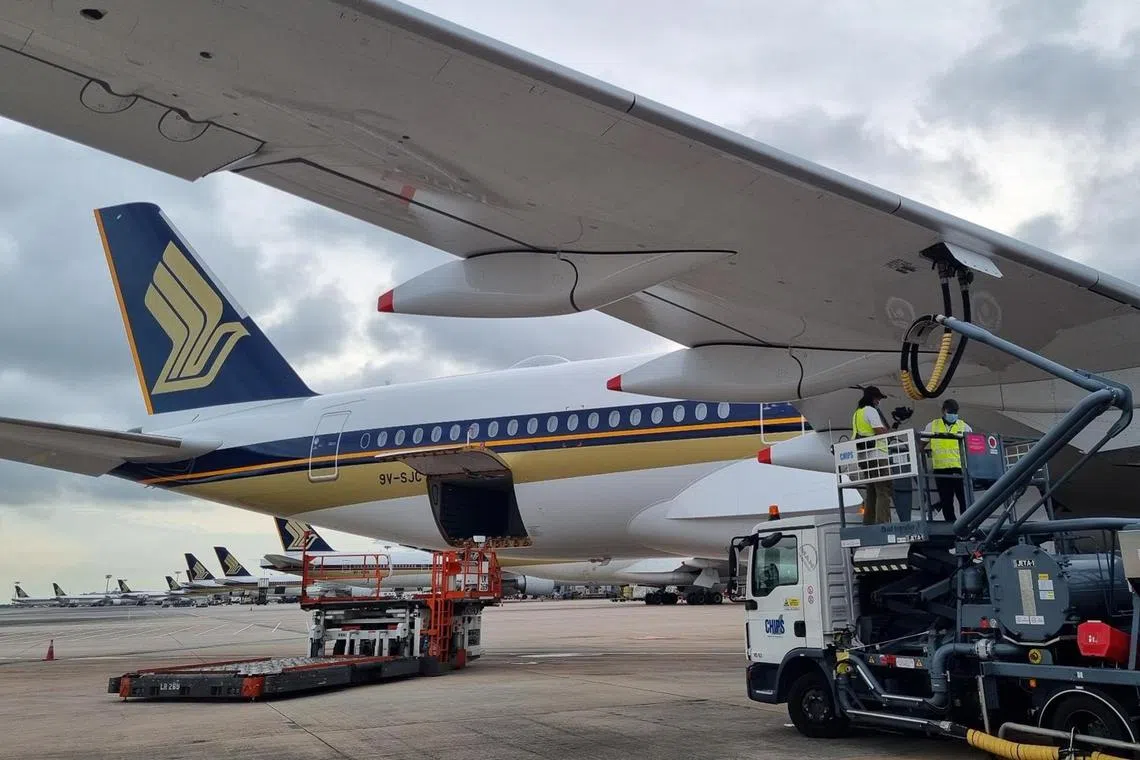Temasek pressing ahead with its green targets; sustainable investment portfolio grows
Sign up now: Get ST's newsletters delivered to your inbox

Singapore Airlines is one of Temasek's 17 portfolio companies that contribute to the majority - 91 per cent - of its total portfolio emissions.
PHOTO: EXXONMOBIL
Follow topic:
SINGAPORE - Temasek said it is pressing ahead with its sustainable living investments and green targets, despite the uncertain geopolitical situation and some pullback in other countries.
Temasek’s chief sustainability officer Park Kyung-ah said at a media briefing on the firm’s 2025 sustainability report out on July 9: “We are staying the course in terms of addressing tomorrow’s needs and, certainly, given the urgency of climate change that is already upon us, that is a key need that we have to address.”
Temasek has an aim of reaching net zero in its portfolio emissions by 2050.
“We remain committed to our target… and we are not taking the foot off our pedal,” she added.
This commitment comes as Temasek grew its portfolio value of sustainable living trend-aligned investments to $46 billion in the 2025 financial year ended March 31, up $2 billion compared with the previous year.
Sustainable living trend-aligned investments include companies with products and services that seek to fulfil environmental and social objectives, as well as those that will benefit from sustainability opportunities.
Temasek’s chief investment officer Rohit Sipahimalani said: “We have stepped up our investments in the sustainable living trend in the past year, compared with the previous year.”
He added that the pullback in other parts of the world should not change Temasek’s approach towards investing in this space.
The US withdrew from the Paris Agreement earlier in 2025, when US President Donald Trump took office.
Major banks and asset managers such as JP Morgan, Goldman Sachs and Morgan Stanley have pulled out of net-zero initiatives such as the Net-Zero Banking Alliance, which brings together banks that want to align their lending and investing activities with net-zero emission targets.
Mr Sipahimalani said: “Technically, with regard to what’s happening on the regulatory front or policy front, you can see that even the large US multinationals… are still very committed towards their net-zero goals.
“So we’ve not seen a change (in the end goal of) moving towards a lower-carbon world, moving away from fossil fuels into renewables. And therefore, we see significant opportunities to participate in that transition in ways that can be financially attractive, regardless of government subsidies.”
Ms Park also told The Straits Times in an interview that the news that dominates the headlines can be different from what is happening on the ground.
This is because some companies engage in greenhushing, which refers to the practice of companies under-reporting or withholding information on their sustainability targets and achievements to avoid any backlash from stakeholders, for instance.
For some companies, this can be about pulling out of public commitments but still doing the hard work in sustainable investing and implementing environmental initiatives.
Ms Park said that there is also the rising cost of inaction when it comes to the climate, as insurance and disaster recovery have cost the United States US$1 trillion (S$1.28 trillion) over a year, or 3 per cent of its gross domestic product.
Temasek’s managing director for sustainability Franziska Zimmermann added that there is much uncertainty around the macro environment and global politics, but no uncertainty when it comes to climate change.
“The science is clear… we may not be absolutely clear on how it’s going to play out, how quickly… but directionally that’s super clear,” she said.
Ms Park added that Temasek’s sustainable targets have not changed, but how the company gets there might need fine-tuning according to evolving circumstances.
Temasek aims to cut its total portfolio emissions by 2030 to 11 million tCO2e, which refers to tonnes of carbon dioxide equivalent – a standard unit of measurement used in greenhouse gas emissions accounting – and hit net zero by 2050.
Its financial year 2025 portfolio emissions stood at 21 million tCO2e, the same as in financial year 2024. But nine million tCO2e of that figure was attributed to Singapore Airlines (SIA), with the increased demand for air travel.
SIA is one of Temasek’s 17 portfolio companies that contribute to the majority – 91 per cent – of its total portfolio emissions.
Temasek is engaging SIA in its decarbonisation efforts.
SIA also has the aim of achieving net-zero carbon emissions by 2050, which requires strategies such as investing in new-generation aircraft, attaining higher operational efficiency and adopting low-carbon technology like sustainable aviation fuel.
Ms Park said: “Our 2030 target is ambitious, but we are staying on course. The reason for that is, the more we delay action, the higher the costs are going to be and the more material the risks will be… We do see a fair number of opportunities to lean in and capture returns as well as sustainable outcomes.”

While Temasek has stepped up its sustainable living trend-aligned investments, the proportion of its net portfolio value exposed to such investments fell to 11 per cent in the financial year 2025, from 12 per cent the year before.
In total, its net portfolio value reached a record $434 billion.
Ms Park said Temasek does not have targets for what proportion of the portfolio sustainable investments should take up.
“We are looking for the best opportunities… so in line with that, sustainable living trends will not be a linear pathway, in terms of growing by XYZ year on year,” she said.
“But over the past year, we have deployed $4 billion... so despite these questions around headwinds, we are actually seeing opportunities for more deployment.”
She added that Temasek is not making concessional investments, but commercial ones that will deliver returns.
Temasek also wants its portfolio companies to become sustainability champions and leaders, she said.
“New deployment matters, but existing engagement of portfolio companies and enabling Singapore champions to become sustainable and resilient in value creation is also something we are very focused on.”


